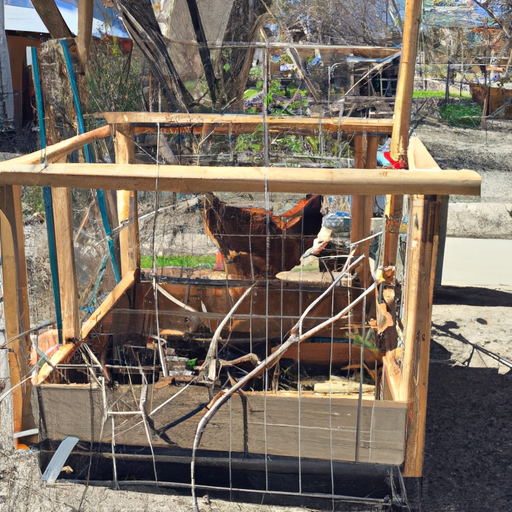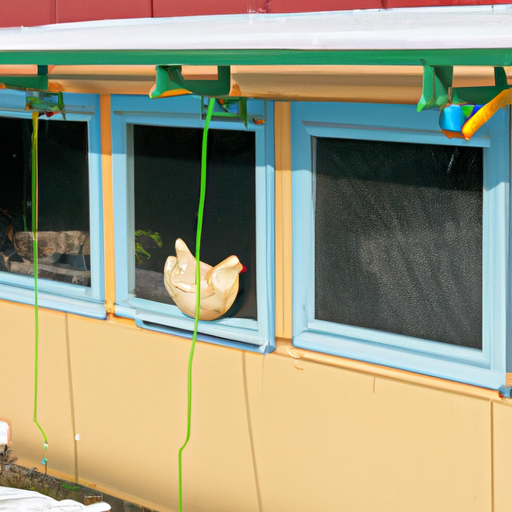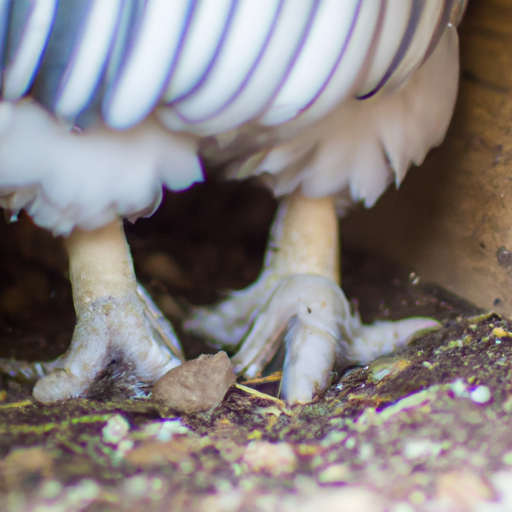In your small yard, you might wonder how to ensure that your chickens get enough exercise. With limited space, it can be challenging to provide them with a stimulating environment that keeps them active and engaged. However, there are several innovative and practical solutions that can help you meet this need. By incorporating simple additions to your yard and implementing clever strategies, you can keep your chickens happily moving and pecking, even in a limited space. Let’s explore some effective ways to provide adequate exercise for your beloved feathered friends!
Creating a Chicken-Friendly Environment
Designing a Chicken Run
Creating a chicken run is an essential part of providing a chicken-friendly environment. A chicken run provides a safe space for your chickens to roam and exercise while still being protected from predators. When designing a chicken run, it’s important to consider the size and layout. Aim for at least 10 square feet per chicken to allow for sufficient movement. You can use fencing or chicken wire to enclose the area and ensure it is predator-proof. Additionally, consider adding a roof or cover to protect your chickens from the elements.
Utilizing Vertical Space
In a small yard, it’s important to make the most of the available space. Utilizing vertical space can provide additional areas for your chickens to explore and exercise. You can install horizontal perches or platforms at different heights to encourage your chickens to climb and jump. Adding ramps or ladders can also create opportunities for them to exercise their leg muscles while exploring different levels. By utilizing vertical space, you can maximize the exercise options for your chickens even in a limited area.
Adding Perches and Platforms
Perches and platforms are not only great for utilizing vertical space, but they also provide your chickens with comfortable resting and roosting spots. Install perches at various heights and with different widths to cater to the preferences of different chicken breeds. Adding platforms, such as tree stumps or wooden boxes, can create additional areas for your chickens to perch, play, and exercise. By providing these elevated spaces, you are promoting a more dynamic and engaging environment for your chickens.
Choosing the Right Chicken Breeds
Selecting Breeds that Thrive in Small Spaces
When choosing chickens for a small yard, it’s important to consider breeds that are well-suited for limited space. Some chicken breeds, such as the Sussex, Rhode Island Red, or Orpington, tend to be adaptable and thrive in smaller environments. These breeds are known for being calm, friendly, and relatively low-maintenance. Researching different breed characteristics can help you choose chickens that are content with a smaller living area, ensuring they can still get adequate exercise and remain healthy and happy.
Considering Bantam or Miniature Breeds
Another option to consider for a small yard is bantam or miniature chicken breeds. Bantam chickens are smaller in size compared to standard-sized breeds, making them well-suited for limited spaces. The smaller size allows bantams to navigate more easily in confined areas and require less space for exercise. Some popular bantam breeds include the Silkie, Serama, and Pekin. These breeds not only provide a compact and adorable addition to your flock but also ensure your chickens have enough room to exercise and move around comfortably.
Exploring Active and Foraging Breeds
If you are hoping to provide more exercise and mental stimulation for your chickens, consider exploring active and foraging breeds. Breeds such as the Australorp, Faverolles, or Plymouth Rock are known for their energetic nature and love for exploring. These breeds can keep themselves entertained by foraging for insects, scratching in the dirt, and exploring their surroundings. By choosing active and foraging breeds, you can create a stimulating environment that encourages your chickens to be active and engage in natural behaviors.
Implementing Enrichment Activities
Providing Toys and Novel Objects
Enrichment activities are essential for keeping chickens mentally stimulated and engaged. One way to achieve this is by providing them with toys and novel objects. Chickens love to explore and peck at new objects, so consider introducing items such as hanging treats, pecking balls, or mirrors. These objects can keep your chickens entertained and provide mental stimulation. Remember to regularly rotate the toys to maintain their novelty and prevent boredom.
Introducing Natural Foraging Opportunities
Chickens have a natural instinct to forage, so incorporating opportunities for them to engage in this behavior is crucial. Scatter treats or pieces of vegetables in the chicken run or around the yard to encourage them to search for food. Chicken-friendly foraging boxes or treat-dispensing toys can also be added to provide further challenges. Not only will these activities keep your chickens active, but they will also satisfy their natural foraging instincts.
Organizing Obstacle Courses and Agility Training
For a more interactive and challenging form of exercise, consider setting up obstacle courses or agility training for your chickens. You can create simple courses using cones, poles, or tunnels that the chickens need to navigate through. Teach them to jump over low hurdles or maneuver through a maze. This not only provides physical exercise but also improves coordination and mental stimulation for your chickens. With patience and positive reinforcement, your chickens can learn and enjoy these fun exercises.
Incorporating Daily Exercise Routines
Establishing a Daily Free-Range Period
Allowing your chickens to have a daily free-range period is an excellent way to provide them with exercise and mental stimulation. During this time, open the chicken run or let them explore a designated area in your yard. Ensure the area is predator-proof and supervise them to prevent any potential dangers. Free-ranging allows chickens to stretch their wings, roam, and engage in natural behaviors like dust bathing and foraging. Providing a safe and supervised environment for free-ranging is essential for their overall well-being.
Encouraging Chicken Scavenger Hunts
Chicken scavenger hunts offer a fun and interactive way for your chickens to exercise. Hide treats or smaller toys around their enclosure or free-range area, challenging them to find and collect their rewards. This activity not only encourages physical exercise but also stimulates their problem-solving skills and natural instincts. Remember to place the treats in safe areas, away from potential hazards, to ensure the chickens’ safety and enjoyment.
Arranging Regular Wing Flapping Sessions
Wing flapping is an important exercise for chickens, as it helps in strengthening their wing muscles and maintaining good circulation. Set aside regular sessions where you encourage your chickens to engage in wing flapping activities. Clear a space in their enclosure or free-range area that allows for unobstructed movement. By making wing flapping a routine, you promote a healthy exercise habit for your chickens and help them maintain strong and healthy wings.
Promoting Social Interaction
Keeping More Than One Chicken
Chickens are social animals and thrive in the company of their flockmates. Keeping more than one chicken ensures they have social interaction and companionship, which contributes to their overall well-being. When designing your chicken-friendly environment, make sure to provide enough space for multiple chickens to move around comfortably. A vibrant flock dynamic promotes natural behaviors, increases exercise opportunities, and helps chickens establish a pecking order.
Arranging Chick Dates or Playdates
Introducing new chickens to your existing flock can be done through “chick dates” or playdates. These supervised interactions allow chickens to socialize, establish hierarchies, and engage in playful behaviors. When initially introducing new members, ensure a gradual integration process to minimize stress and aggression. By arranging regular chick dates or playdates, you encourage social interaction, reduce boredom, and foster a cohesive flock.
Encouraging Flock Dynamics and Pecking Order
Chickens naturally form a pecking order within their flock, which establishes social hierarchies and reduces aggression. It’s crucial to allow chickens to establish their flock dynamics and pecking order, as interfering can disrupt their natural social structure. By providing ample space, adequate resources, and a balanced flock composition, you can promote healthy social interactions and ensure your chickens have a positive and enriching environment.
Integrating Environmental Stimuli
Providing Access to Sunlight and Fresh Air
Sunlight and fresh air are vital for the health and well-being of chickens. Ensure their enclosure or free-range area has access to natural light and ventilation. The sun provides essential vitamin D and promotes overall health, while fresh air keeps the environment clean and reduces the risk of respiratory problems. If your chickens spend a significant amount of time indoors, consider adding windows or skylights to maximize natural light and fresh air circulation.
Creating Wind and Sound Stimuli
Creating wind and sound stimuli in your chicken-friendly environment can help simulate natural outdoor environments. Install wind chimes or windsocks in the chicken run area to provide gentle sounds and movement. This can help stimulate the chickens’ senses and create a dynamic environment. Additionally, playing soothing or nature sounds in the background can have a calming effect on your chickens, promoting a stress-free and relaxing atmosphere.
Designating a Dust Bathing Area
Chickens love to dust bathe, which is a behavior that helps them keep their feathers clean and free from parasites. Designate a specific area within their enclosure where they can indulge in this natural behavior. Fill the area with loose soil, sand, or a mixture of diatomaceous earth and sand. By providing a dedicated dust bathing area, you allow your chickens to exercise their natural instincts and maintain their feather health.
Implementing Training Techniques
Teaching Basic Commands and Signals
Contrary to popular belief, chickens are capable of learning and responding to basic commands and signals. Teaching them simple commands like “come,” “go,” or “jump” using positive reinforcement techniques can be an enjoyable training experience for both you and your chickens. Start with short training sessions, use treats as rewards, and be patient throughout the process. By implementing training techniques, you not only provide mental stimulation but also strengthen the bond between you and your chickens.
Training Chickens to Use Obstacle Courses
Training chickens to use obstacle courses is a great way to enhance their exercise routine and mental agility. Start with simple obstacles like small hurdles or low platforms and gradually increase the difficulty level. Use treats or positive reinforcement to encourage your chickens to navigate the course. Training chickens to use obstacle courses not only improves their physical coordination but also keeps their minds active and engaged.
Implementing Positive Reinforcement
Positive reinforcement is a powerful tool when training and enriching the lives of chickens. Use treats, verbal praise, or clicker training to reward desired behaviors and actions. Reinforcing positive behaviors encourages chickens to continue engaging in those behaviors and creates a positive association with training sessions and activities. Through positive reinforcement, you can train your chickens, enrich their environment, and strengthen your bond with them.
Utilizing Chicken Toys and Play Equipment
Investing in Chicken Swings and Climbing Frames
Chicken swings and climbing frames are popular play equipment that can provide entertainment and exercise for chickens. Swings simulate natural perching behavior, allowing chickens to exercise their balance and leg muscles. Climbing frames offer opportunities for exploration, climbing, and jumping. These toys not only encourage physical exercise but also provide mental stimulation. Invest in well-built, chicken-safe play equipment that is appropriately sized for your chickens to ensure their safety and enjoyment.
Using Chicken-Friendly Tunnels or Mazes
Chicken-friendly tunnels or mazes offer a unique and exciting form of exercise for chickens. These can be constructed using simple materials like PVC pipes or cardboard boxes with openings and pathways for chickens to navigate through. The tunnels or mazes provide an enjoyable challenge for chickens, promoting physical exercise and mental stimulation. Regularly changing the layout or adding new obstacles keeps the activity fresh and interesting for your chickens.
Offering Pulley Systems and Balance Boards
For a more interactive and challenging playtime, consider incorporating pulley systems and balance boards into your chicken-friendly environment. Pulley systems with hanging treats can encourage chickens to problem-solve and engage their muscles while reaching for the rewards. Balance boards provide opportunities for exercise and physical coordination as chickens balance and walk along the board. These interactive toys allow for creative play and help your chickens stay active and engaged.
Developing a Healthy Diet and Treats
Enhancing the Diet with Greens and Vegetables
A well-balanced diet is essential for the overall health and exercise capacity of your chickens. Add a variety of greens and vegetables to their diet to ensure they receive essential vitamins, minerals, and fiber. Leafy greens like kale, spinach, and Swiss chard provide nutritional value, while vegetables such as carrots, zucchini, and peas add variety and flavor. Offering these fresh foods can encourage your chickens to exercise and forage as they peck and explore their meals.
Providing High-Quality Chicken Feed
High-quality chicken feed is the foundation of a healthy diet for your chickens. Choose a commercial feed specifically formulated for your chickens’ age and breed. Look for feed that contains a well-balanced mixture of grains, protein, vitamins, and minerals. Feeding your chickens a proper diet ensures they have the energy and nutrients needed for exercise and overall well-being. Always provide fresh water alongside their feed to keep your chickens hydrated and healthy.
Selecting Nutritious and Safe Treats
Treats can be an excellent incentive for exercise and training, but it’s essential to choose nutritious and safe options. Treats should be given in moderation and, ideally, consist of healthy alternatives to promote exercise. Fruits like berries, melons, or apples can be given as occasional treats. Mealworms or high-protein treats, such as dried shrimp or insects, can also be added to their diet. Always check that treats are chicken-safe, free from pesticides, and do not jeopardize their overall nutrition.
Regular Health Checkups and Care
Ensuring Vaccinations and Parasite Control
Maintaining the health of your chickens is essential for their overall well-being and exercise ability. Consult with a veterinarian to ensure your chickens are up-to-date on vaccinations and parasite control measures. Regular vaccinations protect against common poultry diseases, while parasite control prevents issues like mites and worms. Keeping your chickens healthy reduces the risk of illness or infestations that may hinder their exercise routines.
Conducting Regular Physical Examinations
Regular physical examinations allow you to monitor your chickens’ overall health and catch any potential issues early on. Perform routine checks for signs of injury, abnormal behavior, or changes in appetite. Inspect their feathers, eyes, legs, and vent for any abnormalities or signs of discomfort. Monitor their weight and condition to ensure they are maintaining a healthy body condition. Conducting regular physical examinations helps you address any health concerns promptly and ensure optimal exercise capacity.
Monitoring for Signs of Illness or Stress
Stress or illness can significantly impact your chickens’ exercise ability and overall well-being. Be vigilant and monitor for any signs of illness or stress, such as reduced activity, decreased appetite, changes in droppings, or abnormalities in behavior. If you notice any concerning symptoms, consult with a veterinarian to address the issue promptly. Early detection and intervention help maintain your chickens’ health, allowing them to continue exercising and engaging in their natural behaviors.
By following these guidelines and implementing the suggestions provided, you can create a chicken-friendly environment that promotes exercise, mental stimulation, and overall well-being for your feathered friends. Remember that each chicken is unique, so observe their behaviors and preferences to tailor activities and care. With a little creativity and attention to their needs, you can ensure your chickens lead happy, healthy, and active lives in even the smallest of yards.




